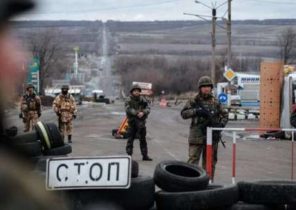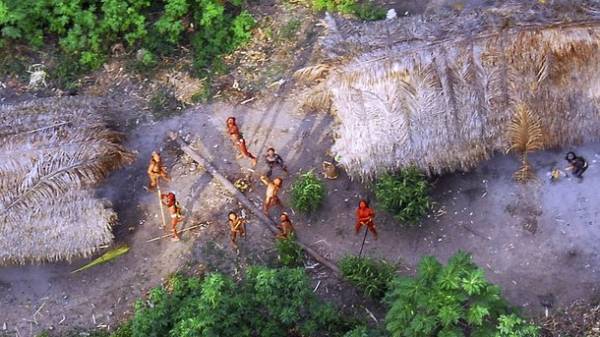
Jeans, electricity and penicillin have long played a role even in the least developed parts of our planet. However, there are people who not only do not seek the benefits of civilization, but prefer to live in the stone age in a literal sense of the word. Some do not even know how to make fire! And while they aggressively resist lubimimi attempts to establish contact with them and give them the blessings of civilization.
In 2013, the scientific journal New Scientist has calculated that there are about a hundred of such non-contact peoples. Most of them, according to the magazine, lives in a remote forest regions of South America, Central Africa and New Guinea. Of their existence known to scientists only by images from satellites or from neighboring tribes, which clashed with the militant wild neighbors.
Often these people are very small. Satellite images usually show a maximum of a few hundred people. The largest proximity Jimaima tribe in Brazil has a maximum of fifteen hundred people. And one of the smallest, known under the name Cara Preta (“Black face”), only about 30 people. Most live as our ancestors did thousands of years ago — hunt animals, catch fish and collect edible berries and plants in the forests. They use primitive tools, I don’t know what metal is and are not engaged in agriculture.
Some tribes fled from civilization to save their lives.
For example, Mashko-Piro (also known as Coherence) went deep into the jungles of Eastern Peru in the early XX century, when part of their tribe was killed on the orders of a local rubber Baron Carlos Fitzcarrald. The tycoon was a private army of mercenaries that dealt with people living in the forests to cut down the forest for plantations of rubber. Today Mashko-Piro are on the verge of extinction, as well as their Arawak language. About the settlement of this tribe in the remote jungles on the border with Brazil became known in the beginning of this century, when there was held a scientific expedition. Hut Mashko-Piro was photographed from aboard a light aircraft that is very scared of the Indians. Scientists did not dare to descend, so as not to infect their inhabitants familiar to modern human viruses, but from which there is no immunity in the inhabitants of the Amazonian rain forest. However, now these natives are threatened by deforestation.
BRAZIL
It is in this country is home to the most isolated peoples — more than 50. Here, unlike other countries in the region, the authorities allocated for the accommodation of each of the people isolated areas where entrance is strictly forbidden to outsiders. The right to live on the ancestral lands of indigenous peoples guarantees the Brazilian Constitution. But in practice not everything is so smooth. Developers and large-scale farmers continue the illegal felling of jungle, and the “hindering” their business development people are trying to drive deeper into the forest.
“Recently, representatives of the tribe Kalapalo on the river Xingu said about the explosion at the waterfall Atascosa. This place is sacred to them, because it is believed that there is God Taugi created the first people. Shocked Indians went to look at the destroyed waterfall. It turned out that there stem of the river. The builders have offered them monetary compensation. But the money they do not need. This river has existed for thousands of years, the tribe drinks water from this source. If with it something happens, this nation will survive?!” — wrote the American journalist David Gran, which explores the life of the wild tribes of the Amazon. Police often investigate these genocides of small Nations, but before trial and sentencing comes rarely, due to the lack of documented evidence.
On the banks of the river Mahi survives by hunting, fishing and gathering wild Piraha tribe, numbering about 400 people. The peculiarity of this tribe, who call themselves “straight” (and indeed, they have a very upright posture) is their unique language. There are no words for colors, no indirect and no numerals words (the Indians consider one, two and many). They have no legends about the creation of the world, no calendar… they Live in mono-ethnic villages without a leader. Journalist John Colapinto visiting Pirahan in 2006, described their village as a group along the banks of the huts, which have only a roof of palm leaves, without walls and floor. The only furniture was a bed in the form of a wooden platform. In this decade the tribe started to contact with civilization and have already explored the possibilities of gunpowder. However, to teach children at least account bad at it.
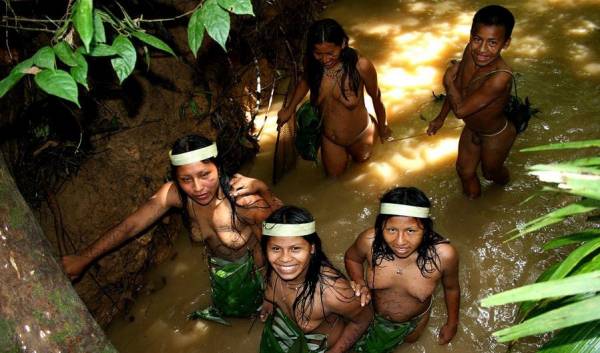
It is in the jungles of Brazil is home to the most isolated peoples – more than five dozen
INDIA: THE PROUD AND THE ISLAND IN ISOLATION
The Andaman and Nicobar Islands in the Bay of Bengal of India is home to many tribes. Most came into contact with the outside world in the XX century. But some still live in isolation. For example, the tribe Jarawa. In the 1950s, the years of their settlement in the woods was bombed, to clear the area for the construction of the only road through the island of Middle Andaman. Deforestation led to armed resistance garav, which in the end left alone. Now jarawa occasionally clashed with the Indian settlers when they violate the limits of their possessions.
The tribe, which now numbers no more than 400 people, all know your proud temper.
For a long time, anthropologists who visited the area, left Bank gifts — fabric, bunches of bananas, packages of rice. However, all these gifts until recently were rejected — they were found dumped in the sea. Only in 1974 the representatives of the Indian missionary service and the aboriginal managed to get the location of this tribe and since then once a month bring the tribe of “humanitarian aid” in the form of Fig. Sometimes members of the tribe come to the hospital for medical aid, and the units send their children to village schools. Some just go on the road to look at the passing buses and cars.
Since then, the view of the Andaman “savages” came thousands of tourists from all over the world, many of which have made a real Safari natives. For the sake of beautiful photos of tourists lure garav alcohol and tobacco. Women threw trinkets and asked to dance. In 2013, the government of India has criminalized any attempt to get in touch with Garavani. Buses that pass on the only road near their settlement, accompanied by an armed convoy. Stopping is prohibited. Any attempt to get in touch with the tribe, whether it be a photograph, a handshake or even a gift, faces up to seven years in prison. Now activists want to close this road and only use the ferries. The case reached the Supreme court.
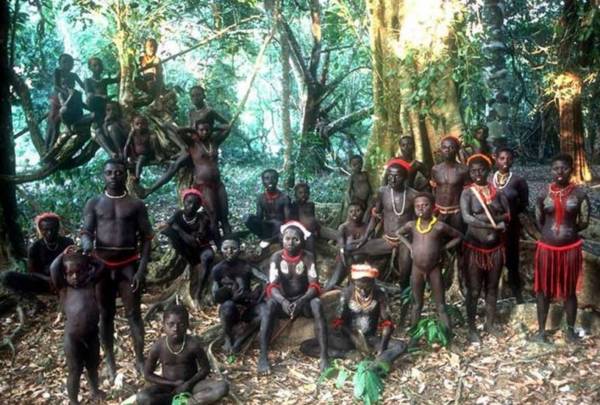
Tribe Jarawa. They come to see thousands of tourists a year
But not all residents of Andaman are even such contact. On the North Sentinelese island inhabited by the sentinelese, who live in total isolation somewhere in the 60 thousands of years. Scientists believe that they still do not know how to make fire and keep smoldering embers produced from a lightning strike in a tree, in earthen vessels. The main diet is marine products. The Indian government attempted to make contact with this tribe since the 1960-ies, sending back the boat with the fish and gifts. The gifts that were cast into the sea, the sentinels were out but did not stop to threaten with bows and stones.
SEE ALSO
- The President from the untouchables: what is known about the new head of India
Flop was and expedition of the international geographic society National Geographic in 1974. The Director of the crew was wounded by an arrow. From gifts sentinels took only aluminum cookware and coconuts, a pig and a baby doll buried in the sand.
Attempts to establish contact with the sentinelese was terminated in the 1990-ies, although police helicopters are regularly monitoring the situation on the island to make sure the tribe is all right. At present, their exact population is unknown and, according to various estimates, from 40 to 500 people. Most likely, some of the people died during the tsunami after the earthquake in the Indian ocean in 2004.
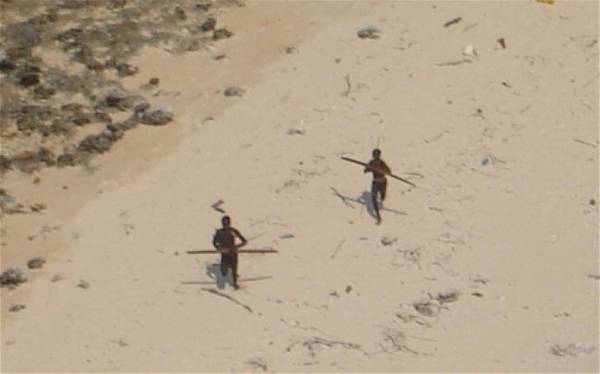
A Tribe Of Sentinels. They could not survive the tsunami after the earthquake in the Indian ocean
PHILIPPINES: TRIBE FOR PR AND SINS OF CIVILIZATION
Some politicians are willing to use savage tribes for self-promotion or PR of their country. So did Filipino politician Manuel Elizalde, who in 1971 announced the discovery in Mindanao of the tribe Tasaday. According to him, in the caves of the island completely isolated from civilization dwelt among 26 people who have survived by catching crabs and frogs. They wear loincloths of leaves, and was so peaceful that they never conflict with each other and have no idea what a fight.
The news aroused great interest all over the world. Elizade closed territory of tasadi and allowed to only the elect. About the ideal society, the tribe wrote to all the leading journals of the world, was filmed dozens of documentaries. But a few years later the cave secretly visited the Swiss anthropologist and found out that they are empty, and tasaday live in huts nearby, engaged in agriculture and are dressed in t-shirts and jeans. Then it became known that tasaday though we live in a primitive system, but at the time “discovery” had long been in contact with neighbors from the surrounding settlements and took over from them the skills of ordinary agriculture, and even simple metal tools. Now tasaday continue to live in Mindanao, and their people is a little over two hundred people.
PROTECTION. The tribes have protection at the international level — the organization Survival International, which deals with the consolidation of the wild peoples right of ownership of the land where they live for centuries.
The organization also debunks the myths surrounding non-contact tribes. For example, it is believed that such people should be forcibly integrated into a society for their own good. In fact, experts say Survival International, “the savages,” if left alone, it is not a disaster. Collected photos of these tribes we usually see strong, athletic men and women, in families in which many well-fed children. In warm climates among hunter-gatherers food is much more than they need. And they don’t even need to take care of zagotavlivali provisions for the cold season.
“These people are not retarded and not savages. They are in their stage of development and have the right to decide how to live on their land,” says Rebecca Spooner from Survival International. At the same time we should not imagine their life is rosy, says Spooner: “We do not believe that these people lead a happy heavenly life, and their society harmoniously. Like everywhere it has its problems. They just live differently.” By the way, attempts to “civilize” members of such tribes often end in failure. Even if they don’t die from the most banal to the modern man disease-often the natives suffer from alcoholism and drug abuse, which is encountered far from civilization.

About casatico wrote the whole world
THE LONE LEADER
Unfortunately, life outside of civilization may sooner or later lead to the extinction of people. In the jungle of the Western Brazilian state of Rondonia in the last decade there was a lonely warrior, name and age of which is not known. Brazilian police believes that the man is the last member of his tribe, carved in the course of tribalism. In the world he became known as the man of the hole because I left a pit 3 m deep, in which were beasts and hiding from danger. And he was hiding from someone. In 2009, he was tracked down in the woods and tried to shoot the poachers, but, according to the organization for the protection of the rights of peoples contact Survival International, he survived. Brazilian Director Vincent Carelli even managed to capture the man on film.
Next to the loneliest person in the world in the Brazilian state of rondônia lives a tribe of acuns, which today has only four people. All of them are relatives, and therefore can’t marry, and the current generation will be the last in history. When they were found at the end of the last century, the tribe consisted of six Indians and reportedly survived an armed attack by loggers.
Western organizations are trying to preserve at least the information about the vanishing tribes. Dutch billionaire Marcel Buchhorn funded project “before they left us,” in which photographer Jimmy Nelson travels around the world and documents the life of different tribes. Under the project, Nelson has already visited more than 35 different tribes found in Europe, Asia, Africa, South America and the South Pacific ocean.
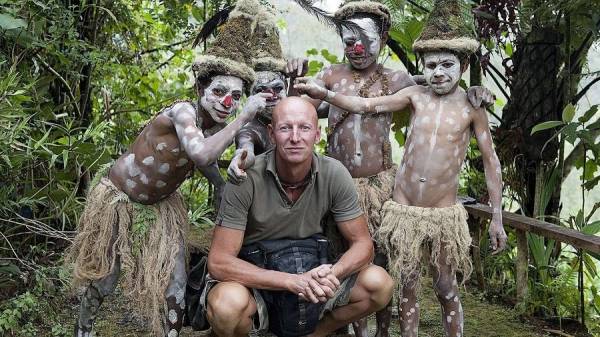
Nelson lived in 35 tribes



